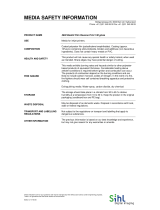
Print date : 2019-12-20 SDS 26453 - Page 8 / 8
Information telephone (Product): +41 (0)800/002050 (Monday - Friday 8:00 - 18:00)
Mobile network: +41 (0)848/000292 (Monday - Friday 8:00 - 18:00)
Swiss Toxicological Information Centre CH-8028 Zürich: +41 (0)44/2515151 or 145
- SECTION 13: Disposal considerations
Waste codes/waste designations according to EWC/AVV: 20 01 29
Relevant H-phrases (Number and full text)
H315 Causes skin irritation.
H318 Causes serious eye damage.
H319 Causes serious eye irritation.
Abbreviations and acronyms
ACGIH® American Conference of Governmental Industrial Hygienists
ADR Accord européen relatif au transport international des marchandises Dangereuses par Route
AICS Australian Inventory of Chemical Substances
BuAc n-Butyl acetate
CAS Chemical Abstracts Service
CCID New Zealand Chemical Classification and Information Database
DSL Canada Domestic Substances List
ECHA-RAC ECHA Committee for Risk Assessment
EFSA European Food Safety Authority
EHSP OECD Environment, Health, and Safety Publication
EmS Emergency Schedule
EU-CLH European Union Harmonised Classification and Labelling
GESTIS Databases on hazardous substances of the German Social Accident Insurance
GHS Globally Harmonised System of Classification and Labelling of Chemicals
GWBB-VLEP Grenswaarden voor beroepsmatige blootstelling/Valeurs limites d'exposition professionnelle
HHS U.S. Department of Health and Human Services
HSDB Hazardous Substances Data Bank
IARC International Agency for Research on Cancer
IATA International Air Transport Association
ICAO International Civil Aviation Organization
IMDG International Maritime Dangerous Goods
IMO International Maritime Organization
INRS French National Research and Safety Institute for the Prevention of Occupational Accidents and Diseases
JP-GHS Japan GHS Basis for Classification Data
KHC Known human carcinogens.
LEL Lower explosion limit
LOLI LOLI (List of Lists) Database
n.a. not applicable
NDSL Canada Non-domestic Substance List
NICNAS Australia National Industrial Chemicals Notification and Assessment Scheme
NIER South Korea National Institute of Environmental Research Evaluations
NLM United States National Library of Medicine
NTP National Toxicology Program
NZIoC New Zealand Inventory of Chemicals
OECD Organisation for Economic Co-operation and Development
OSHA Occupational Safety & Health Administration
OUE European Odour Unit
RAHC Reasonably Anticipated Human Carcinogen
REACH Registration, Evaluation, Authorisation and Restriction of Chemicals
RID Regulations concerning the International Carriage of Dangerous Goods by Rail
SCOEL Scientific Committee on Occupational Exposure Limits (EU)
SIDS OECD Screening Information Data Sets
SUVA Swiss Accident Insurance Fund
TRGS Technische Regeln für Gefahrstoffe
TSCA The Toxic Substances Control Act Chemical Substance Inventory
TWA Time Weighted Average
UEL Upper explosion limit
UN United Nations
US-EPA United States Environmental Protection Agency
Disclaimer: The information provided in this Safety Data Sheet is believed to be correct as of the date issued. Philips Electronics Nederland B.V. makes no warranty as to its contents, nor as to its
fitness for any particular purpose or use.











